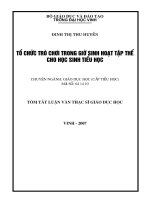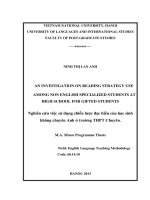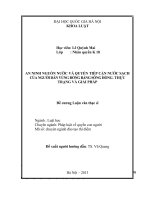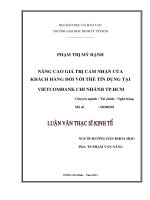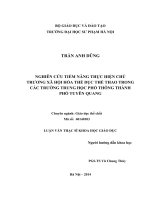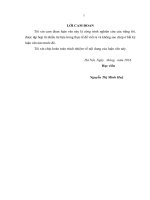(Luận văn thạc sĩ) an investigation into speaking in class anxiety of english majored students the case of the second year students at the school of foreign languages, thai nguyen university
Bạn đang xem bản rút gọn của tài liệu. Xem và tải ngay bản đầy đủ của tài liệu tại đây (1.22 MB, 99 trang )
VIETNAM NATIONAL UNIVERSITY, HANOI
UNIVERSITY OF LANGUAGES AND INTERNATIONAL STUDIES
FACULTY OF POST- GRADUATE STUDIES
-----------o0o------------
TRẦN THỊ PHƯƠNG
AN INVESTIGATION INTO SPEAKING-IN-CLASS ANXIETY
OF ENGLISH-MAJORED STUDENTS: THE CASE OF THE
SECOND-YEAR STUDENTS AT THE SCHOOL OF FOREIGN
LANGUAGES, THAI NGUYEN UNIVERSITY
Nghiên cứu sự lo lắng khi nói tiếng Anh trong lớp học của
sinh viên chuyên Anh: Trường hợp sinh viên năm thứ hai tại
khoa Ngoại Ngữ, Đại học Thái Nguyên
M.A MAJOR PROGRAMME THESIS
FIELD: ENGLISH TEACHING METHODOLOGY
CODE : 60140111
Hanoi, 2016
VIETNAM NATIONAL UNIVERSITY, HANOI
UNIVERSITY OF LANGUAGES AND INTERNATIONAL STUDIES
FACULTY OF POST- GRADUATE STUDIES
-----------o0o------------
TRẦN THỊ PHƯƠNG
AN INVESTIGATION INTO SPEAKING-IN-CLASS ANXIETY
OF ENGLISH-MAJORED STUDENTS: THE CASE OF THE
SECOND-YEAR STUDENTS AT THE SCHOOL OF FOREIGN
LANGUAGES, THAI NGUYEN UNIVERSITY
Nghiên cứu sự lo lắng khi nói tiếng Anh trong lớp học của
sinh viên chuyên Anh: Trường hợp sinh viên năm thứ hai tại
khoa Ngoại Ngữ, Đại học Thái Nguyên
M.A MAJOR PROGRAMME THESIS
FIELD: ENGLISH TEACHING METHODOLOGY
CODE : 60140111
SUPERVISOR: Assoc. Prof. Dr. NGUYỄN PHƯƠNG NGA
Hanoi, 2016
DECLARATION
I hereby declare that this thesis entiled “An Investigation into Speakingin-Class Anxiety of English-Majored students: The Case of the Second-year
Students at the School of Foreign Languages, Thai Nguyen University”
submitted in partial fulfillment of the requirements for the Degree of Master
of Arts is the results of my own work and that this thesis does not contain
material which has been accepted for the award of any degree or diploma in
any university, nor does it contain material previously published or written by
any other person, except where due reference is made in the text of the thesis.
I agree that the origin of my thesis deposited in the library can be
accessible for the purposes of study and research, in accordance with the
normal conditions established by the librarian for the care, loan and
reproduction of the paper.
Hanoi, December 2016
Signature
Tran Thi Phuong
i
ACKNOWLEDGEMENTS
I owe many great thanks to so many people who have supported me all
the way throughout my study to this final achievement.
First of all, I would like to express my special thank to my supervisor,
Assoc. Prof. Dr. Nguyen Phuong Nga, for her wholehearted guidance,
valuable suggestions and academic advice during the course of writing this
thesis, without which this work would hardly have been accomplished.
I would also like to send my sincere thanks to all lecturers at PostGraduate Studies Department, ULIS – VNU who gave me interesting lessons
and comprehensive knowledge.
I also wish to send my deep appreciation to my colleagues and students
at English Department, School of Foreign Languages, Thai Nguyen
University who have encouraged me and helped me with the research data.
Last, to my family, words are not enough to express my gratitude. I am
grateful to my parents, my husband, my little daughter. Without their help and
encouragement, I could not have completed this study.
Hanoi, December 2016
Signature
Tran Thi Phuong
ii
ABSTRACT
Feeling of anxiety, apprehension and nervousness are commonly
expressed in a language classroom by second/ foreign language learners when
learning to speak. These feelings are considered to affect learners‟ speaking
performance. The present study was conducted with the aim to 1) investigate
levels of in-class speaking anxiety experienced by the second-year Englishmajored students at the School of Foreign Languages, Thai Nguyen
university, 2) find out the types of in-class speaking activities that provoke or
reduce students‟ in-class speaking anxiety, and 3) examine what teachers‟
behaviors and characteristics can reduce students‟ anxiety.
The research subjects were 101 SFL students majoring in English in the
two programs, namely English Education Program and English Language
Program. A multi-part survey questionaire was employed to collect the data.
The simple descriptive statistics, namely frequency, percentage were used to
analyze the data.
The findings revealed that the students‟ anxiety about speaking English
in classroom, on the whole, was at the high level. In addition, among the three
categories of language anxiety, namely communication apprehension, test
anxiety, and fear of negative evaluation, it was found that the subjects of the
present study reported fear of negative evaluation and communication
apprehension as the main cause of speaking anxiety.
The findings also showed that the activities with high self-exposure
requirement; namely, make an oral presentation or skit in front of the class,
role play spontaneously in front of the class, or speak in front of the class
were the most anxiety-evoking to students. On the other hand, those activities
gave students a chance to work in pairs or in groups; especially in class games
caused the least anxiety to them.
iii
Regarding the teachers‟ behaviors and characteristics, the findings
showed that the students would feel less anxious if the teacher is patient and
friendly, has a sense of humor, makes students feel comfortable. In addition,
teachers‟ appropriate teaching practices on class management and error
correction are reported to effectively reduce student‟s anxiety and so create a
comfortable learning atmosphere in classroom.
Finally, the pedagogical implications of these findings for understanding
second/foreign language anxiety for enhancing learners‟ communication
abilities in the target langage were discussed, as are suggestions for future
research.
iv
TABLE OF CONTENTS
DECLARATION ........................................................................................... i
ACKNOWLEDGEMENTS ......................................................................... ii
ABSTRACT ................................................................................................. iii
TABLE OF CONTENTS ............................................................................. v
LIST OF TABLES ..................................................................................... vii
LIST OF FIGURES .................................................................................. viii
LIST OF ABBREVIATIONS ..................................................................... ix
PART A: INTRODUCTION ....................................................................... 1
1. Rationale of the study ................................................................................. 1
2. Aims and objectives of the study ............................................................... 3
3. Scope of the study ...................................................................................... 3
4. Significance of the study ............................................................................ 4
5. Methodology .............................................................................................. 4
6. Design of the study ..................................................................................... 4
PART B: DEVELOPMENT ........................................................................ 6
CHAPTER 1: LITERATURE REVIEW .................................................... 6
1.1. Definition of anxiety................................................................................ 6
1.2. Types of anxiety ...................................................................................... 8
1.3. Foreign language anxiety ....................................................................... 10
1.3.1. Definition of foreign language anxiety ............................................... 10
1.3.2. Models of foreign language anxiety .................................................... 11
1.3.3. Manifestation of foreign language anxiety .......................................... 16
1.3.4. Measurement of foreign language anxiety .......................................... 18
1.4. Foreign language speaking anxiety ........................................................ 20
1.4.1. Definition of foreign language speaking anxiety ................................. 20
1.4.2. Speaking as a source of anxiety .......................................................... 20
v
1.4.3. Other sources of foreign language speaking anxiety ........................... 23
1.4.4. Ways of creating a low-anxiety classroom .......................................... 28
1.5. A review of previous studies on speaking-in-class anxiety .................... 32
CHAPTER 2: METHODOLOGY............................................................. 37
2.1. Context of the study .............................................................................. 37
2.2. Participants of the study ........................................................................ 38
2.3. Instruments ............................................................................................ 38
2.4. Data collection procedures .................................................................... 40
2.5. Data analysis ......................................................................................... 41
CHAPTER 3: RESULTS AND DISCUSSION ......................................... 43
3.1. In-class English speaking anxiety .......................................................... 43
3.1.1. Overall of students‟ responses to in-class speaking anxiety ................ 43
3.1.2. In-class speaking anxiety categories ................................................... 50
3.2. Anxiety towards in-class activities ........................................................ 58
3.3. Teachers‟ characteristics and techniques related to anxiety reduction .... 64
PART C: CONCLUSION .......................................................................... 69
1. Summary of the research findings ............................................................ 69
2. Implications .............................................................................................. 70
3. Limitations of the study and suggestions for further research ................... 71
REFERENCES ........................................................................................... 73
APPENDIX .................................................................................................... I
vi
LIST OF TABLES
Table 3.1 Students‟ responses to ICESA scale.............................................. 43
Table 3.2 Students‟ level of in-class speaking anxiety .................................. 48
Table 3.3 Top causes of in-class speaking anxiety ........................................ 49
Table 3.4 Students‟ fear of negative evaluation ............................................ 51
Table 3.5 Students‟ communication apprehension ........................................ 52
Table 3.6 Students‟ test anxiety .................................................................... 56
Table 3.7 In-class speaking activities ........................................................... 58
Table 3.8 In-class speaking activities with high anxiety ............................... 62
Table 3.9 In-class speaking activities with low anxiety ................................ 63
Table 3.10 Students‟ perceptions of teachers‟ behaviors and characteristics . 65
vii
LIST OF FIGURES
Figure 3.1 SFL students‟ perceived anxiety .................................................. 49
Figure 3.2 Categories of in-class speaking anxiety ....................................... 57
Figure 3.3 SFL students‟ perceptions of 17 in-class activities ...................... 61
viii
LIST OF ABBREVIATIONS
CA:
Communication Apprehension
EFL:
English as a Foreign Language
ESL:
English as a Second Language
FLCAS:
Foreign Language Classroom Anxiety Scale
FNE:
Fear of Negative Evaluation
ICESA:
In-Class English Speaking Anxiety
L1:
First Language
L2:
Second Language
SFL:
School of Foreign Languages
TA:
Test Anxiety
ix
PART A: INTRODUCTION
The first chapter presents the rationale for the study. Following this, the
aim and objectives of the study, the research questions, the scope,
significance and methods of the study are presented. The chapter ends with
an overview of the thesis structure.
1. Rationale of the study
Foreign language anxiety is one of the important barriers which may
cause various difficulties for the language learners. This problem limits
learners‟ linguistic improvement, limits learner‟s abilities and also
diminishes potential performance of the learners. In the learning process,
speaking-oriented activities are considered to produce higher anxiety level
among language learners than other class activities.
Walker (1997:23) states that “a student who believes his capacities in
speaking English are inadequate may answer a teacher‟s question using the
fewest words possible in order to protect himself from the possibility of
error, or he may choose to read the answer from the text instead of risking
self-constructed speech.” In the researcher‟s teaching experience, she found
that some students, if confronted with some failure in speaking English,
would remain silent more frequently when being required to speak; some
even lack the courage to try to open their mouths and speak, or stumble and
stammer when they speak. Even though many teachers are aware of the
problem relating to students‟ anxiety, they do not take that big issue into
account. When learners enroll in different language courses, they are offered
only to develop their English but most of the times no systematic steps are
1
taken to reduce their anxiety. As a result, learners who have English
speaking anxiety face difficulties when they are required to speak even after
learning the language for a long time. Therefore, it is time that systematic
attention is paid on this issue to tackle language anxiety and thereby improve
students‟ proficiency in English.
What more, over the last decades, a great body of studies has been
conducted on language anxiety in foreign language and second/ foreign
language learning in general (Scovel, 1978; Horwitz, Horwitz, & Cope,
1986; MacIntyre & Gardner, 1991a, 1991b, 1991c; etc.) and in foreign
language speaking skill in particular (Woodrow, 2006; Liu, 2009; Lu & Liu,
2011; Ozturk & Gurbuz, 2014; Salem & Dyiar, 2014). However, contrary to
what is happening abroad, fewer studies in Vietnam have been conducted
and acknowledged the effects of anxiety on foreign language learning. Only
some empirical studies have touched on the sources of anxiety (Tran et al.,
2013, Nguyen, 2014), and none of them has focused on the English-majored
students of Thai Nguyen university. Obviously, as a teacher at Thai Nguyen
University, the researcher observes that students who are majoring in English
usually experience the feelings of frustration, pressure, and nervousness
during some English classes. Most of them are reluctant to participate in
classroom tasks, especially in English speaking activities.
All of above issues have strongly aroused the researcher‟s interest and
motivated her to conduct the research entitled “An investigation into
speaking-in-class anxiety of English-majored students: The case of the
second-year students at the School of Foreign Languages, Thai Nguyen
university”.
2
2. Aims and objectives of the study
The present study aims to investigate speaking-in-class anxiety with the
main focus on the second-year English-majored students at the School of
Foreign Languages, Thai Nguyen university.
The specific objectives of the present study are:
- To examine the levels of speaking-in-class anxiety experienced by the
second-year English-majored students at School of Foreign Languages, Thai
Nguyen University.
- To investigate the types of in-class activities which cause the most
anxiety to students and which reduce students‟ anxiety.
- To suggest what teachers‟ behaviors and characteristics can reduce
students‟ anxiety in English speaking classroom.
The three research questions this study aims to address are as follows:
1. What levels of anxiety the second-year English-majored students
manifest in English speaking classrooms?
2. What in-class activities provoke or reduce students’ anxiety in
English speaking classrooms?
3. What teachers’ behaviors and characteristics are helpful to reduce
students’ anxiety in speaking English?
3. Scope of the study
Foreign language anxiety exists in the process of learning all four skills,
i.e. listening, speaking, reading and writing (Horwitz, Horwitz, & Cope,
1986). However, within the limitation of the scope of this study, only
students‟ in-class speaking anxiety is focused.
Besides, this study only involves the second-year English-majored
students of two Programs (namely English Education and English Language)
at the School of Foreign Languages, Thai Nguyen university.
3
4. Significance of the study
This present study has important pedagogical implications because
indentifying the level of students‟ speaking-in-class anxiety and causes
contributing to students‟ speaking anxiety in classroom leads to a more
comfortable learning environment for students, and this in turn can improve
students‟ language learning. In addition, the results from this study can help
Vietnamese teachers and undergraduate students become aware of the nature
of foreign language speaking anxiety, and thus, it can let them know how to
reduce English speaking anxiety and to increase students‟ English speaking
proficiency in classroom by using appropriate learning countermeasures.
In addition, the fingdings from this study will shed a light on the utility
of language learning activities in the foreign language classroom, helping
teachers in providing comfortable and supportive environments for their
students where they are able to succeed as language learners.
5. Methodology
In order to answer three research questions, the study involved mainly
quantitative methodology; specifically, the author conducted survey
questionnaires in which different parts will aim at answering the three
research questions. The survey was conducted on the population of the
second-year English-majored students at the School of Foreign Languages,
Thai Nguyen university. The detail of the methodology applied in the study
is discussed in Chapter 2 of Part B.
6. Design of the study
This research consists of three main parts:
- PART A, INTRODUCTION, gives a brief overview of the study
including the rationale, aims and objectives, research methodology, scope,
significance and design of the study.
4
- PART B, DEVELOPMENT, is sub-divided into three chapters.
Chapter 1, Literature Review, presents the review of literature and a critical
analysis on the previous researches in the same field. Chapter 2, Research
Methodology, disccuses the methodology used in the study including the
context of the study, the population information, instrumentation, data
collection procedure and data analysis. Chapter 3, Results and Discussion,
reports an analysis of the data and presentation of the findings.
- PART C, CONCLUSION, records a summary of the findings, a
conclusion, implications for practice, limitations of the study followed by
recommendations for further research.
- References and Appendices are attached at the end of the thesis.
5
PART B: DEVELOPMENT
CHAPTER 1: LITERATURE REVIEW
The purpose of this chapter is to present a review of the literature
related to the present study. It begins with the review of the concept of
anxiety and types of anxiety. This is followed by the discussion of foreign
language anxiety, in which definition,
models,
manifestation and
measurement of foreign language anxiety are the focus. Then, a close picture
of foreign language speaking anxiety is analyzed with its definition, sources,
and techniques to reduce. The chapter ends with the discussion and analysis
of previous studies in relation to the present study.
1.1. Definition of anxiety
The conceptions of anxiety have been attacked long ago by many
behavioral researchers, particularly psychologists. Darwin (1872, cited in
Byrne, 1990: 74) was among the first to systematically address the definition
of anxiety. In his book named The Expressions of the Emotions in Mans and
Animals, he considered anxiety to be an inherent and adaptive characteristic
of both humans and animals that has evolved over countless generations
through a process of natural selection. He also observed that anxiety varied
in intensity from mild apprehension or surprise, to an extreme “agony of
terror”.
Freud (1895, cited in Spielberger and Rickman, 1990:74) describes
anxiety as “something felt” – an unpleasant affective (emotional) state or
condition that was characterized by subjective feelings of chronic
apprehesion and “all that is covered by the word „nervousness‟. Similarly,
Calvin (1955) defines anxiety as a painful emotional experience which is
produced by excitations in the internal organs of the body. These excitations
results from internal or external stimulation and are governed by the
autonmic nervous system. Horwitz, Horwitz, & Cope (1986) give another
6
definition of anxiety which is “the subjective feeling of tension,
apprehension, nervousness, and worry associated with an arousal of
autonomic nervous system” (p.125).
Spielberger & Rickman, in Anxiety and the Heart (1990) also refers
anxiety as an unpleasant feeling of tension, apprehension, nervousness, and
worry, and activation of the autonomic nervous system. According to them,
the physiological manifestations in anxiety generally include increased blood
pressure; rapid heart rate; sweating; dryness of the mouth; nausea; vertigo
(diziness); irregularities in breathing; muscle tension; and muscular-skeletal
disturbances such as restless, tremors, and feelings of weakness.
Clearly, even though we all know what anxiety is and we all have
experienced feelings of anxiousness, anxiety is still not easy to be defined in
a simple sentence or in a single manner. Therefore, Rachman (2004), a
clinical psychologist, presents one of the most complete and useful
descriptions of anxiety. According to Rachman (2004:3), anxiety is the tense,
unsettling anticipation of a threat, a feeling of suspended uneasiness. It is
clearly distinguished from fear in terms of its “causes, duration, and
maintainance”, although in general anxiety and fear are considered to be
similar to each other. Anxiety is diffuse, objectless, unpleasant, and
persistent. Fear, on the other hand, is specific, episodic, and reduced when
the danger is removed. In other words, anxiety can be felt constantly and
often with no specific reason, while fear is felt only while a specific negative
situation pervails.
To sum up, anxiety has been discussed for many years in a variety of
fields and these discussions show that anxiety has been essential for almost
all areas to understand human behaviors, emotions, and physical and mental
conditions. Within the scope of the thesis, Horwitz, Horwitz, & Cope‟s
approach is adopted.
7
1.2. Types of anxiety
Generally, anxiety is categorized into two kinds: state anxiety and trait
anxiety. This distinction, first put forward by Cattell and Scheier (1960), was
then firmly established by Spielberger et al. (1970) with the development of
a measurement scale, the State-Trait Anxiety Inventory.
State anxiety, according to Spielberger (1966, cited in Deyuan, 2011:
13), is defined as “an immediate, transitory emotional state of subjective,
conscious feelings of tension, apprehension, nervousness, and worry
associated with an arousal of the autonomic nervous system in response to a
particular stimulus such as giving a speech or taking an examination”.
Trait anxiety, in contrast, is viewed as “an inherent personality
characteristic” or “a relatively stable tendency to exhibit anxiety in a large
variety of circumstances” (Phillips, 1992: 14). In other words, individuals
who are more anxious and more likely to become anxious regardless of
situations are referred to as having trait anxiety.
A strong correlation between state and trait anxiety has been claimed
in the literature, which means that people having trait anxiety are more likely
to have state anxiety (Aydin, 2001). Particularly, individuals with high levels
of trait anxiety are expected to show greater evaluations of state anxiety in
stressful situations. However, MacIntyre and Gardner (1991c) stated that
people who have the same trait anxiety scores may react differently in
different situations. In their study, for example, two subjects having the same
trait anxiety scores were compared in terms of their responses to the social
situations given in the subscales of the fictitious trait anxiety scale. The
situations were written tests or exams, novel situations and dangerous
circumstances. It was found that the first subject did not feel anxious in
written exams, but felt nervous in social situations. In contrast, the second
8
subject felt anxious in written exams but did not feel anxious in social
situations. For novel and dangerous situations, they had the same score.
Another distinction is made between two other types of anxiety:
facilitating and debilitating anxiety. These types of anxiety refer to the
effects that anxiety has on learning process, showing whether anxiety
improves or impairs performance.
Facilitating anxiety, first proposed by Alpert and Haber (1960, cited in
Sellers, 2000), is stated to influence the learner in a positive, motivating way
and is described as enthusiasm before a challenging task. According to
Scovel (1978), this type of anxiety “motivates the leaner to „fight‟ the new
learning task; it gears the learner emotionally for approach behavior”
(p.136). In addition, Krashen (cited in Young, 1992) believes that facilitative
anxiety has a positive effect on language learning, but only on tasks that
require concious learning, not on language acquisition. Language
acquisition, in his opinion, works best when anxiety is zero, when it is
directed somewhere else, not on language. In other words, in order to acquire
language, the person has to assume that s/he will be successful.
Debilitating anxiety, on the other hand, includes the unpleasant feelings,
such as worry and dread that interfere with the learning process. It
“motivates the learner to „flee‟ the new learning task; it stimulates the
individual emotionally to adopt avoidance behavior” (Scovel, 1978: 139).
Therefore, it is called the “bad” type of anixety in the literature.
According to Allwright & Bailey (1991), to work with a relaxed
concentration and to achieve success, learners should minimize the sources of
debilitating anxiety by optimizing the sources of facilitating anxiety. They
believe that when success is guaranteed in the people‟s mind, when there is no
reason to be anxious at all, they may not produce the best. If success is not
9
guaranteed, if there is a possibility of failure, by making a real effort, people
may do better because their anxiety facilitates their performance. On the other
hand, if people believe that they cannot be successful no matter how hard they
try, their anixety may make it even more difficult for them to produce their best.
In conclusion, the notion of facilitative anxiety has brought some
reseachers into conflict with other researchers. Some believe that anxiety has
no motivating role at all, arguing that anxiety has only a debilitating role. For
example, Horwitz, Horwitz, & Cope (1986) believe that facilitating anxiety
can be only be helpful for very simple learning tasks, but not for language
learning involving more complicated tasks. Therefore, in the following part
of the section, the author will look at foreign language anxiety in a more
detailed way and explain its effects on foreign language learning.
1.3. Foreign language anxiety
1.3.1. Definition of foreign language anxiety
Horwitz, Horwitz, & Cope (1986: 128) provided three “useful
conceptual building blocks” for a description of foreign language anxiety;
namely communication apprehension, fear of negative evaluation, and test
anxiety. Communication apprehension is characterized as one‟s discomfort
in communicating with others. Fear of negative evaluation is defined as
apprehension about what others will say or feel about one‟s performance.
Finally, test anxiety involves worry over one‟s performance in an evaluative
situation. However, they noticed that foreign language anxiety is not simply
the combination of these fears transferred to foreign language anxiety.
Rather, foreign language anxiety is conceived as “distinct complex of selfconceptions, beliefs, feelings and behavior related to classroom learning
arising from the uniqueness of the language learning process”.
10
Moreover, foreign language anxiety, a complex and multidimensional
phenomenon, can also be defined as “the apprehension experienced when a
situation requires the use of a second language with which the individual is
not fully proficient.” (Gardner & MacIntyre, 1993: 5). It is, therefore, seen as
a stable personality trait referring to the tendency for an individual to react in
a nervous manner when speaking, listening, reading, or writing in the second
language.
Sharing the same perspective towards the concept of foreign language
anxiety, Richards and Schmidt (2010: 313) define foreign language anxiety
in the following way:
Foreign language anxiety is a situation – specific anxiety, similar in that
respect to public speaking anxiety. Issues in the study of language anxiety
include whether anxiety is a cause or an effect of poor achievement, anxiety
under specific instructional conditions, and the relationship of general
language anxiety to more specific kinds of anxiety associated with speaking,
reading, or examinations.
Generally speaking, although most of the researchers view foreign
language anxiety as a situation-specific anxiety related to second language
learning, the definition of foreign language anxiety proposed by Hortwitz,
Horwitz, & Cope (1986) is, to date, assessed to be “the most complete and
realistic description of anxiety as well as the most realiable measurement in
anxiety in second language acquisition” (Takayuki, 2008: 17)
1.3.2. Models of foreign language anxiety
1.3.2.1. Horwitz, Horwitz, & Cope’s model of foreign language anxiety
Horwitz, Horwitz, & Cope (1986) outlined a theoretical framework of
Foreign Language Anxiety, and identified foreign language anxiety as a
seperate and distinct phenomenon particular to language learning. Their
11
framework consists of three components, communication apprehension, test
anxiety, and fear of negative evaluation.
Communication apprehension is defined as “a type of shyness
characterized by fear of or anxiety about communicating with people”
(Horwitz, Horwitz, & Cope, 1986: 127). It refers to an individual‟s level of
fear or anxiety associated with either real or anticipated oral communication
with another person or persons. Therefore, difficulties in speaking in groups
or in publics, or in listening to or learning a spoken message are considered
all manifestations of communication apprehension. FLA is further regarded
to be logically relevant to the construct of communication apprehension
since “one will almost certainly have difficulty understanding others and
making oneself understood” especially in the situation of having to
communicate in a foreign language (Horwitz, Horwitz, & Cope, 1986: 127).
Test anxiety refers to “a type of performance resulting from a fear of
failure” (Horwitz, Horwitz, & Cope, 1986: 127). Test anxiety is also closely
related to the discussion of FLA because “performance evaluation is an
ongoing feature of most foreign language classes” (p.127). Test-anxious
students might suffer quite a number of difficulties in foreign language class
since tests and quizzes are frequent and even the smartest and most prepared
students cannot avoid making errors from time to time. Of all the tests and
quizzes, oral ones are especially anxiety-provoking since anxious students
probably manifest both communication apprehension and test anxiety in this
kind of test (Horwitz, Horwitz, & Cope, 1986).
Finally, fear of negative evaluation is the “apprehension about others‟
evaluations, avoidance of evaluative situations, and the expectation that
others would evaluate oneself negatively” (Horwitz, Horwitz, & Cope, 1986:
128). Although similar to test anxiety, fear of negative evaluation is not
12
limited to test-taking situations; rather, it may occur in any social, evaluative
sitations such as inteviewing for a job or speaking in foreign language class”
(Horwitz, Horwitz, & Cope, 1986). In addition, fear of negative evaluation is
broader in scope than test anxiety in that it pertains both to the teacher‟s
evaluation of the students and to the perceived reaction of other students.
Although three constructs above “provide useful conceptual building
blocks for the description of foreign language anxiety”, Horwitz, Horwitz, &
Cope (1986: 128) propose that FLA is not just the sum of these fears
transferred to FL learning. Rather, they conceive foreign language anxiety as
“a distinct complex of self-perceptions, beliefs, feelings, and behaviors
related to classroom language learning arising from the uniqueness of the
language learning process” (p. 128).
1.3.2.2. Tobias’ model of foreign language anxiety
Tobias (1986) proposes a model of the effects of anxiety on learning
from instruction. According to the model, interference may occur at three
stages: input, processing, and output.
At the input stage, the language learners are expected to store as much
input as they can. Anxiety at this stage refers to the anxiety experienced by
learners when they encounter a new word or phrase in the target language. It
suggests that learners with high anxiety would experience difficulty because
of less attentional capacity than their low anxiety peers.
The processing stage involves the cognitive operations performed on
the subject matter, i.e. organization, storage and assimilation of the material.
At this tage, language learners are expected to be able to process the inputs
they take in from the input stage.If the inputs or tasks are more difficult,
more heavily reliant on memory and more poorly organized, anxiety impairs
13
the learners‟ cognitive processing. At this stage, the operation of input
information, anxiety acts as a distraction.
Lastly, the output stage involves the production of previously learned
information. At this stage, language learners are required to express their
ability to use the second language. Performance at this stage is highly
dependent on their previous stages. At this stage, it is more likely that
communication anxiety will appear. Anxiety at the output stage refers to
learners‟ nervousness or fear experienced when they are required to
demonstrate their ability to use the previously learned material. Incomplete
information intake or input anxiety has an impact on the information
operation in the processing stage and can result in reduced ability to perform
foreign or second language at the output stage.
To sum up, the combined effects of language anxiety at all three stages
can explain why the students with lower levels of anxiety, when compared to
high anxious students, tend to learn better.
1.3.2.3. Foss and Reitzel’s model of foreign language anxiety
For conceptualizing how anxiety interferes with the attainment of
competence in second language classrooms, Foss and Reitzel (1988)
proposed a framework of language anxiety. There are five components of
their framework: motivation, knowledge, skills, outcomes and context.
Motivation is associated with the avoidance response to a particular
communcation situation. Specifically, some L2 learners may choose not to
communicate in a situation because they judge their capacities to be so poor.
Knowledge consists of a repertoire of behavioral patterns and strategies
upon which a person draws in order to decide how to communicate in a
given situation. This is done since learning a language may be especially
anxiety producing and gaining the knowledge of a second language might
14
